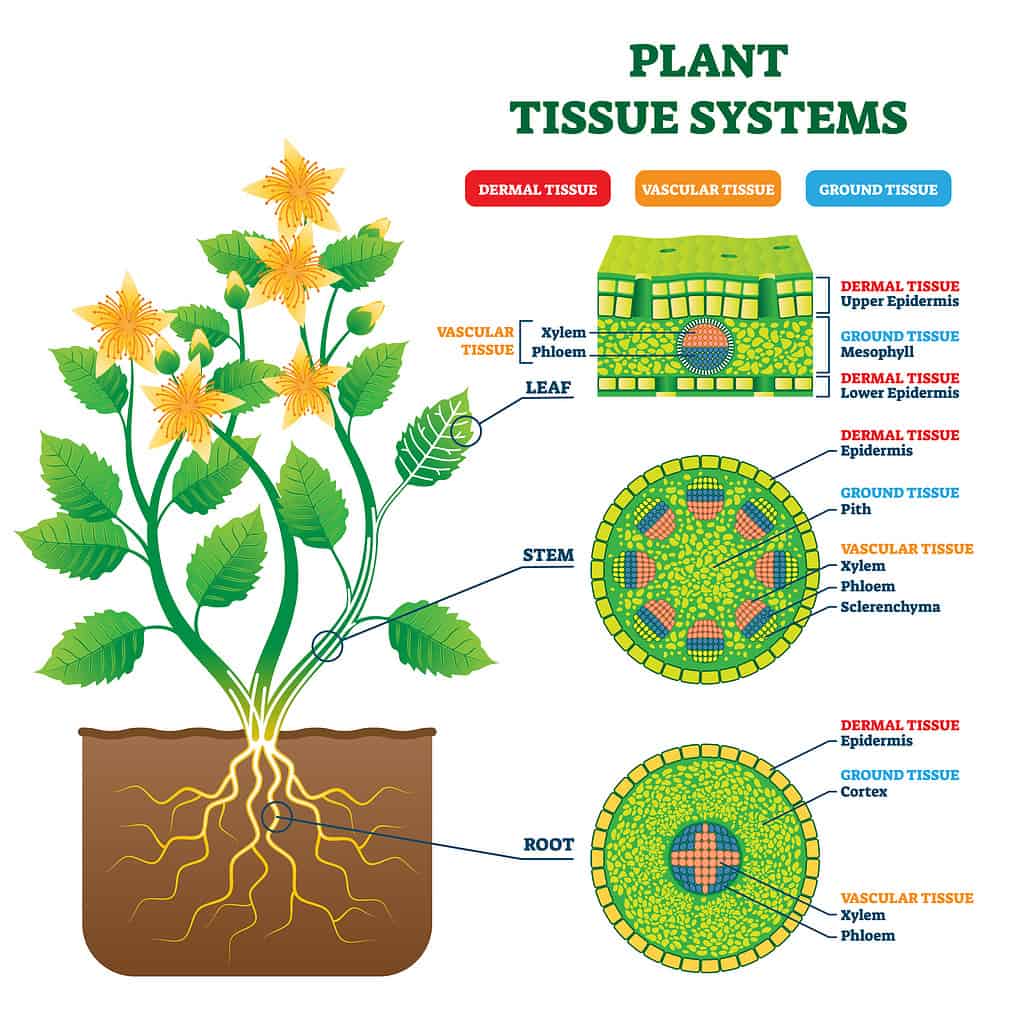Tissue is a word that has more than a single meaning. It’s often described as muscle, ligaments, the fat cells beneath the skin, tendons, and more. There are animal tissues and plant tissues. Tissue’s true meaning, in biological terms, is a group of specific cells that act together to perform a particular function.
Tissue cells are highly organized and there are four types. Though “tissue” is often associated with mammals or humans, it also applies to plants. The four types of tissues are muscle, connective, epithelial, and nervous. The three types of plant tissues are dermal, ground, and vascular.
Four Types of Animal Tissue

There are four types of animal tissue: connective, muscle, nerve, and epithelial.
©VectorMine/Shutterstock.com
No matter what kind of animal tissue it is, they all serve similar purposes and are highly organized. Various groupings of the four tissues make up everything in the human body (except bones), including organs, veins, arteries, the heart, eyes, hair, and muscle.
Connective Animal Tissue
Connective tissue is just what it sounds like. It serves a connective function, such as tendons, cartilage, or various ligaments throughout the body. However, “connective” goes beyond just connections between bones and muscles or the makeup of the nose and ears.
Connective tissues exist in every single attachment in the human body. For instance, connective binds the stomach to the small intestine and the small intestine to the colon. Connective tissue, whether hard or soft, consists primarily of a gel substance, with fibrous strands.
Muscle
The muscles are a huge part of the body. While many often associate it with connective tissue, even they aren’t the same. The muscle category is just that—muscle. There are three types of muscle: skeletal, smooth, and cardiac.
The cardiac muscle is the muscle of the heart and it’s the densest. As a striated muscle, its responsible for contracting in a rhythmic pattern, pushing blood and oxygen through the body. Skeletal muscle connects muscle to bone and makes up the most muscle in the body. Like cardiac muscle, skeletal muscle is also striated.
Smooth muscle is located around the organs, especially in the digestive system. It helps to move food through the body as the digestion process takes place.
Nervous
The peripheral nerves, the spinal cord, and the brain contain the most nervous tissue. The entire brain is made up of nervous tissue, which is typically gray and white. Nervous tissue, much like the nerves, also carries signals throughout the body.
Epithelial
This type of tissue makes up much of the skin, the inner lining of the intestinal wall, the reproductive system, and the trachea. It’s the material most responsible for protecting the organs by creating enzymes that form the outer walls. It’s also responsible for absorption. For instance, when you put lotion on your hands, the skin absorbs much of the lubrication, thanks to epithelial tissue.
Three Types of Plant Tissue

There are three different types of plant tissue: vascular, ground, and dermal.
©VectorMine/Shutterstock.com
Plants have tissue just like animals. A difference between them, though, is that plants have three types of tissue rather than four.
Vascular
The xylem and phloem make up the vascular tissue in plants. These tissues are designed for materials transportation throughout the plant, such as minerals, water, and nutrient that the plant needs for survival. Essentially, they make up the “blood vessels” of the plant.
Ground
There are three types of ground tissue: parenchyma, collenchyma, and sclerenchyma. This type of tissue resides between the layers of vascular, serving as a sort-of filler material that also serves a critical function. The ground tissue is responsible for photosynthesis, repair, and storage.
Dermal
Stems, leaves, roots, and flowers are covered in a thin layer of material, which is known as dermal tissue, or epidermis, just like the epidermal skin of human beings. Like human skin, it serves as a shield and as a semi-structure, helping to hold the plant up. Also like human skin, the epidermal does most of the absorption.
Tissue Pronunciation
Tissue is pronounced: tish – oo



